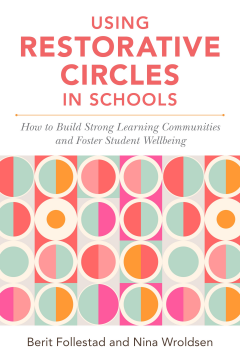
Additional Information
Book Details
Abstract
Restorative circles are an effective way of implementing restorative justice, through starting a conversation wider than just the victim and the offender.
Proven to be an effective way of healing and building relationships, tackling bullying within schools and providing a sense of community, this book gives everything needed for a school to start implementing restorative circles.
Accompanied by illustrations, interviews and case studies to show how to start using restorative circles, this practical guide is the perfect introduction for schools looking to improve their methods of conflict resolution.
Berit Follestad is a school counsellor with over 20 years' experience as a conflict mediator, and is a certified facilitator of restorative circles. She is an experienced trainer for trainers in the use of restorative practices and is guest lecturer at university colleges.
Nina Wroldsen has many years' experience using restorative circles as a school teacher and school leader, and has lectured internationally on the field of restorative processes.
Table of Contents
| Section Title | Page | Action | Price |
|---|---|---|---|
| Using Restorative Circles in Schools by Berit Follestad and Nina Wroldsen | 9 | ||
| Foreword by Belinda Hopkins | 9 | ||
| Introduction | 13 | ||
| Why This Book? | 13 | ||
| Introducing the Authors | 14 | ||
| Restorative Practice and Students – the Connection Between Positive Learning Environments and Student Wellbeing | 14 | ||
| Students | 15 | ||
| The School Environment | 16 | ||
| The Roots of Restorative Circles | 16 | ||
| A Note on Language | 17 | ||
| Part 1. Restorative Circles – a Mindset, a Method and Tool for Conflict Resolution | 19 | ||
| Circles – an Ancient Tradition | 22 | ||
| Circle – a Symbol of Community and Restorative Values | 22 | ||
| The Role of the Facilitator | 24 | ||
| The Structure of a Restorative Circle | 24 | ||
| Talking Piece | 27 | ||
| The Background of Problem-Solving Circles | 27 | ||
| Two Paradigms | 28 | ||
| Nonviolent Communication | 29 | ||
| Restorative Questions | 32 | ||
| Part 2. Implementing the Circle Method | 37 | ||
| Planning the Implementation Process | 38 | ||
| The Framework for Restorative Circles | 40 | ||
| Creating an Inclusive Learning Community | 42 | ||
| The Quiet Students | 43 | ||
| Circle Time: Having Fun – Learning Together | 44 | ||
| Outline of the First Circle Time | 46 | ||
| Restorative Circles as a Daily Routine | 48 | ||
| Outline of a Dialogue Workshop | 49 | ||
| Peer Education | 51 | ||
| Circle Time Used in Tutor Groups | 52 | ||
| Outline of the Use of Circle Time in Tutor Groups | 53 | ||
| Fostering Wellbeing While Working on Academic Subjects | 55 | ||
| Outline of the Use of Restorative Practices in Academic Subjects | 57 | ||
| Part 3. Restoring Relations | 61 | ||
| Schools – Arenas for Socialisation | 61 | ||
| Violence, Noise and Unrest | 62 | ||
| The Bystander Effect | 62 | ||
| How does this relate to the classroom? | 63 | ||
| How to Change Misbehaviour in Class | 63 | ||
| Conflict Escalation | 64 | ||
| Conflict as Property | 65 | ||
| The Social Disciplinary Window | 69 | ||
| Can Restorative Approaches Be Offered in Cases of Bullying? | 70 | ||
| Bullying on Social Media | 75 | ||
| Preparations for a Restorative Meeting | 77 | ||
| Frequently Asked Questions | 79 | ||
| The Micro Circle | 80 | ||
| Fostering Student Wellbeing – a Whole-School Approach | 83 | ||
| Part 4. Games and Activities | 85 | ||
| Check-in | 85 | ||
| Fruit Salad | 86 | ||
| The Sun Shines on… | 86 | ||
| Hurricane | 87 | ||
| Positive Name Game | 87 | ||
| Hi, Hi, Hi | 88 | ||
| Four Corners – An Activity on Moral Dilemmas | 88 | ||
| Break the Code | 89 | ||
| The Dot | 90 | ||
| Counting Together – 1–2–3 | 91 | ||
| My Triggers | 92 | ||
| Paper – Not Floor | 92 | ||
| Listening at Several Levels | 93 | ||
| The Conflict Tree Diagram | 95 | ||
| Lederach: Conflict Escalation | 97 | ||
| Zip, Zap, Bop | 98 | ||
| ‘I’ Message and ‘You’ Message (Giraffe and Jackal Language) | 99 | ||
| Four Small Words | 100 | ||
| Who is the Leader? | 101 | ||
| Personal Road Map | 102 | ||
| The mountain | 103 | ||
| The Mug | 104 | ||
| What is Hidden Behind Anger? | 105 | ||
| Restorative Questions | 106 | ||
| Check-out – Evaluation | 106 | ||
| Give a Compliment | 107 | ||
| Tap on the shoulder | 108 | ||
| The pyramid of confirmation/acknowledgement | 108 | ||
| Texas Hug | 108 | ||
| Jump Together | 108 | ||
| Bibliography | 111 | ||
| Internet Resources | 113 | ||
| Index | 115 |
